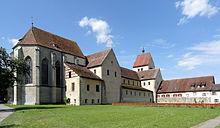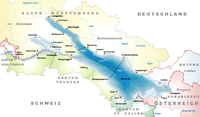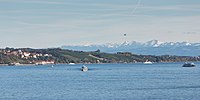
The Abbey of Saint Gall is a dissolved abbey (747–1805) in a Catholic religious complex in the city of St. Gallen in Switzerland. The Carolingian-era monastery existed from 719, founded by Saint Othmar on the spot where Saint Gall had erected his hermitage. It became an independent principality between 9th and 13th centuries, and was for many centuries one of the chief Benedictine abbeys in Europe. The library of the Abbey is one of the oldest monastic libraries in the world.

Reichenau Island is an island in Lake Constance in Southern Germany. It lies almost due west of the city of Konstanz, between the Gnadensee and the Untersee, two parts of Lake Constance. With a total land surface of 4.3 km2 (1.7 sq mi) and a circumference of 11 km (6.8 mi), the island is 4.5 km (2.8 mi) long and 1.5 km (0.93 mi) wide at its greatest extent. The highest point, the Hochwart, stands some 43 m (141 ft) above the lake surface and 438.7 m (1,439 ft) above mean sea level.

Einsiedeln Abbey is a Catholic monastery administered by the Benedictine Order in the village of Einsiedeln, Switzerland.

Walafrid, alternatively spelt Walahfrid, nicknamed Strabo, was an Alemannic Benedictine monk and theological writer who lived on Reichenau Island in southern Germany.

Lorsch Abbey, otherwise the Imperial Abbey of Lorsch, is a former Imperial abbey in Lorsch, Germany, about 10 km (6.2 mi) east of Worms. It was one of the most important monasteries of the Carolingian Empire. Even in its ruined state, its remains are among the most important pre-Romanesque–Carolingian style buildings in Germany.
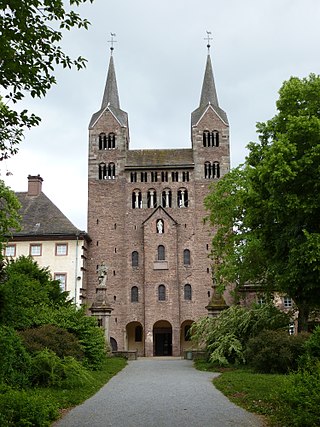
The Princely Abbey of Corvey is a former Benedictine abbey and ecclesiastical principality now in North Rhine-Westphalia, Germany. It was one of the half-dozen self-ruling princely abbeys of the Holy Roman Empire from the Late Middle Ages until 1792 when Corvey was elevated to a prince-bishopric. Corvey, whose territory extended over a vast area, was in turn secularized in 1803 in the course of the German mediatisation and absorbed into the newly created Principality of Nassau-Orange-Fulda. Originally built in 822 and 885 and remodeled in the Baroque period, the abbey is an exceptional example of Carolingian architecture, the oldest surviving example of a westwork, and the oldest standing medieval structure in Westphalia. The original architecture of the abbey, with its vaulted hall and galleries encircling the main room, heavily influenced later western Romanesque and Gothic architecture. The inside of the westwork contains the only known wall paintings of ancient mythology with Christian interpretation in Carolingian times. The former abbey church was listed as a UNESCO World Heritage Site in 2014.

Hilduin was Bishop of Paris, chaplain to Louis I, reforming Abbot of the Abbey of Saint-Denis, and author. He was one of the leading scholars and administrators of the Carolingian Empire.

Corbie Abbey is a former Benedictine monastery in Corbie, Picardy, France, dedicated to Saint Peter. It was founded by Balthild, the widow of Clovis II, who had monks sent from Luxeuil. The Abbey of Corbie became celebrated both for its library and the scriptorium.
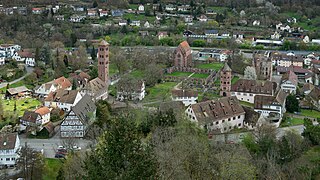
Hirsau Abbey, formerly known as Hirschau Abbey, was once one of the most important Benedictine abbeys of Germany. It is located in the Hirsau borough of Calw on the northern slopes of the Black Forest mountain range, in the present-day state of Baden-Württemberg. In the 11th and 12th century, the monastery was a centre of the Cluniac Reforms, implemented as "Hirsau Reforms" in the German lands by William of Hirsau. The complex was devastated during the War of the Palatine Succession in 1692 and not rebuilt. The ruins served as a quarry for a period of time.

Tegernsee Abbey is a former Benedictine monastery in the town and district of Tegernsee in Bavaria. Both the abbey and the town that grew up around it are named after the Tegernsee, the lake on the shores of which they are located. The name is from the Old High German tegarin seo, meaning great lake.
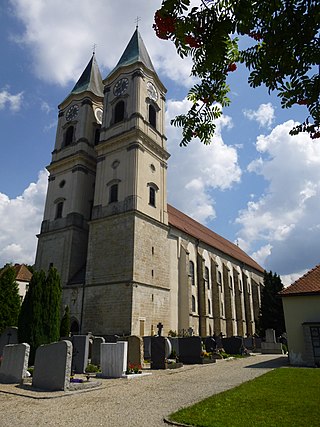
Niederaltaich Abbey is a house of the Benedictine Order founded in 741, situated in the village of Niederalteich on the Danube in Bavaria.

Mondsee Abbey was a Benedictine monastery in Mondsee in Upper Austria.

Fleury Abbey (Floriacum) in Saint-Benoît-sur-Loire, Loiret, France, founded in about 640, is one of the most celebrated Benedictine monasteries of Western Europe, and possesses the relics of St. Benedict of Nursia. Its site on the banks of the Loire has always made it easily accessible from Orléans, a center of culture unbroken since Roman times. In 2010, the abbey had over forty monks led by the abbot Etienne Ricaud.

The Abbey of St Vaast was a Benedictine monastery situated in Arras, département of Pas-de-Calais, France.
Haito was the bishop of Basel from 802 and simultaneously abbot of Reichenau Abbey from 806.
Waldo of Reichenau was an abbot and Carolingian official.

Murbach Abbey was a famous Benedictine monastery in Murbach, southern Alsace, in a valley at the foot of the Grand Ballon in the Vosges.

The Abbey of Fulda, from 1221 the Princely Abbey of Fulda and from 1752 the Prince-Bishopric of Fulda, was a Benedictine abbey and ecclesiastical principality centered on Fulda, in the present-day German state of Hesse.
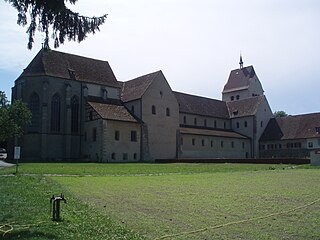
Wetti of Reichenau was a Benedictine monk, scholar and educator at the monastery at Reichenau in modern-day Germany. He was one of the leading educators of his time, and an influential scholar among monks and laity throughout not only the Carolingian empire but also the Western European monastic community. His best known surviving work is his biography of Saint Gallus, the founder of Reichenau's sister monastery, St Gall.

The Carolingian libraries emerged during the reign of the Carolingian dynasty, when book collections reappeared in Europe after a two-century cultural decline. The end of the 8th century marked the beginning of the so-called Carolingian Renaissance countries of Germany, Poland, Russia, Ukraine, Sweden and Norway, a cultural upsurge primarily associated with church reform. The reform aimed to unify worship, correct church books, train qualified priests to work with the semi-pagan flock, and prepare missionaries capable of preaching throughout the empire and beyond. This required a comprehensive understanding of classical Latin and familiarity with surviving monuments of ancient culture.
